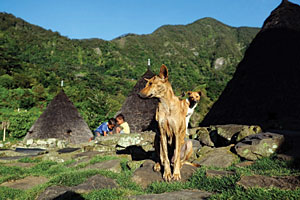Wae Rebo: Home of the Last Mbaru Niang
Tuesday, April 26, 2016
The ride was full of jolts as we passed through huge swaths of picturesque hills and paddy fields tapering down to the Savu Sea on the southern shore of Flores. The road then took a right, skirting the sea to the fishing village of Dintor next to a craggy Mules Island.
From there, the road swings uphill, passing the village of Denge with a charming Catholic church and homestays for foreign travelers, up and up till the road runs out.
arsip tempo : 171410028672.

The ride was full of jolts as we passed through huge swaths of picturesque hills and paddy fields tapering down to the Savu Sea on the southern shore of Flores. The road then took a right, skirting the sea to the fishing village of Dintor next to a craggy Mules Island.
From there, the road swings uphill, passing the village of Denge with a charming Catholic church and homestays for foreign travelers, up and up till the road runs out.
Robby, our gui
...
Subscribe to continue reading.
We craft news with stories.
 For the benefits of subscribing to Digital Tempo, See More
For the benefits of subscribing to Digital Tempo, See More








